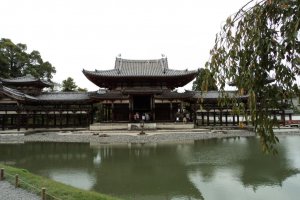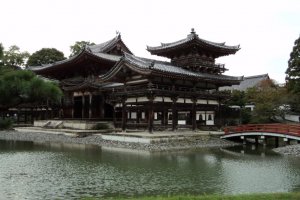Have you ever looked closely at the ten yen coin?
If you plan a trip to Uji, you should make a stop at the Byōdō-in Temple. This building was originally built in 998 during the Heian Period. Minamoto no Shigenobu, the Minister of the Left, then inherited this building from his wife, and used it as a rural villa. After his death, the building was bought by a powerful member of the Fujiwara clan and transformed into a Buddhist temple in 1052. In 1053, the Phoenix Hall, was built and is today one of the few wooden structures that survived multiple fires during the civil war in 1336. It is now listed by UNESCO as an important "Historic Monument of Ancient Kyoto".
The Phoenix Hall got its name from the two phoenix statues displayed on the roof. Those statues eventually gave the present name of the temple, Hōō-dō or Phoenix Hall, instead of the original name, Amida-dō. There are three open corridors that lead to the central room, which houses an image of Amida Buddha.
In front of the hall there is a large pond in which you can see the reflection of the building in the water. Many visitors try to capture this reflection with their camera. Byōdō-in Temple is also surrounded by a beautiful garden which is a national-designated historic site. Visitors can also visit the Byōdō-in museum located inside a modern building a short walk away. A number of national treasures are displayed with multilingual information about the history and construction of the temple. There is also a theater with animated puppets that recreates the famous Tale of Genji story.
For an extra 300 yen, visitors can enter the Phoenix Hall as part of a short 20 minutes guided tour only available in Japanese

































In addition, we intend to implement a proofreader role at JapanTourist in the near future. This will give rewards points to contributors who would like to help clean up typos and oversights in articles on the site. Email info@japantourist.jp if this interests you.
Sentence #5: "...and is today one of the few original wooden structure that survived multiples fires during the civil war in 1336." Oops, that would be 'wooden structures that survived multiple fires...". Who's editing this stuff?
Hate to drag it out further, but "Visitors can also visit the Byōdō-in museum located inside a modern building not too close from the ancient structures." Should be 'not too close to the original structures.'
And..."Multiples national treasures..." Huh? Try, 'Multiple national treasures'; the correct English. Far too many plural adjectives make for a bad impression of a newbie writer.